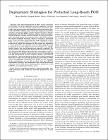| dc.contributor.author | Ruffini, Marco | en |
| dc.date.accessioned | 2012-06-21T15:57:48Z | |
| dc.date.available | 2012-06-21T15:57:48Z | |
| dc.date.issued | 2012 | en |
| dc.date.submitted | 2012 | en |
| dc.identifier.citation | Marco Ruffini, Deepak Mehta, Barry O'Sullivan, Luis Quesada, Linda Doyle, David B. Payne, Deployment Strategies for Protected Long-Reach PON, IEEE/OSA Journal of Optical Communications and Networking, 4, 2, 2012, 118 - 129 | en |
| dc.identifier.other | Y | en |
| dc.identifier.uri | http://hdl.handle.net/2262/63930 | |
| dc.description | PUBLISHED | en |
| dc.description.abstract | The mass deployment of ?bre access networks is probably the most important network upgrade strategy for operators over the coming decade. Next generation networks, and in particular the Long-Reach Passive Optical Network (LR-PON) solution, aim to increase long term economic viability and sustainability of Fibre-To-The-Premises (FTTP) deployment. The LR-PON solution achieves this by minimising the number of nodes and the amount of electronic equipment required within the network. Since a LR-PON replaces the metro backhaul network, which is usually a protected part of the network, protecting the long reach part of LRPON network against failures becomes a critical issue that needs to be taken into account. In this paper we introduce a novel protection mechanism that, by spreading the load generated by a node failure over the network, can signi?cantly reduce the overall protection capacity required. We then present a practical FTTP deployment scenario based on our protected LR-PON architecture for a European country.
The problem is modeled using Integer Linear Programming and the optimisation results, obtained using a real dataset provided by a national operator, show that a small number of Metro/Core nodes can provide protected connection to FTTP users. By applying a detailed cost model to the outcome of the optimisation we are able to show that our LR-PON deployment strategy that minimises the overall protection capacity, rather than just minimising ?bre distances in the LR-PON, can signi?cantly reduce costs. | en |
| dc.description.sponsorship | This work is supported by Science Foundation Ireland
Grant No. 10/CE/I1853. | en |
| dc.format.extent | 118 | en |
| dc.format.extent | 129 | en |
| dc.language.iso | en | en |
| dc.relation.ispartofseries | IEEE/OSA Journal of Optical Communications and Networking | en |
| dc.relation.ispartofseries | 4 | en |
| dc.relation.ispartofseries | 2 | en |
| dc.rights | Y | en |
| dc.subject | Protected Long-Reach | en |
| dc.subject | network protection and resiliency | en |
| dc.subject | Optical networks | en |
| dc.subject | network optimization | en |
| dc.title | Deployment Strategies for Protected Long-Reach PON | en |
| dc.type | Journal Article | en |
| dc.type.supercollection | scholarly_publications | en |
| dc.type.supercollection | refereed_publications | en |
| dc.identifier.peoplefinderurl | http://people.tcd.ie/ruffinm | en |
| dc.identifier.rssinternalid | 76766 | en |
| dc.identifier.doi | http://dx.doi.org/10.1364/jocn.4.000118 | en |
| dc.subject.TCDTheme | Smart & Sustainable Planet | en |
| dc.identifier.orcid_id | 0000-0001-6220-0065 | en |
| dc.contributor.sponsor | Science Foundation Ireland (SFI) | en |
| dc.contributor.sponsorGrantNumber | 10/CE/I1853 | en |




